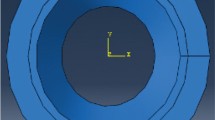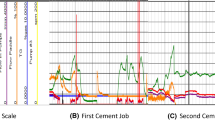Abstract
In this paper, the casing strings of cement slurry during the curing period are taken as the research object in order to build a force model, with comprehensively considering the influence factors such as the phase transition heat transfer and volume change of the cement slurry during the curing period. The random contacts between casings and well walls were simulated by establishing a gap element between two phases of cement slurry. Formulas of axial loadings on the casings during curing of cement slurry were obtained using the finite element method. With this method and on-site measurement, the wellhead axial loads of three wells during cement slurry curing were calculated and tested. The results revealed that the maximum relative deviation between the theoretical prediction results by the model and the actual field test data was 10.42%, indicating that the model established is reliable. Finally, using the established finite element calculation method, the effects of the cementing section length on extra loadings on the wellhead were analyzed. This study serves as an accurate reference to calculations of extra loadings on the wellhead during curing of cement slurry and optimization of cementing section length, thus facilitating well cementation.











Similar content being viewed by others
Abbreviations
- q :
-
Casing mass per unit
- ρ s :
-
Density of casing material
- ρ i(l):
-
Density of fluids in the casing (varies with well depth)
- ρ 0(l):
-
Density of the medium at depth of l in the casing
- h 0 :
-
Length of cementing section
- ρ t(l):
-
Density of pad fluids (varies with well depth)
- ρ n(l):
-
Density of cement slurry (varies with well depth)
- A s :
-
Cross-sectional area of the casing
- T 0(h):
-
Stratum temperature (varies with well depth)
- T(t,h):
-
Casing temperature
- P ci0 :
-
Casing pressure
- α :
-
Well deviation angle
- P co0 :
-
Ground annular pressure
- τ(t,l):
-
Gelation strength at well depth h and moment t
- D :
-
Inner diameter of the well wall
- d :
-
Outer diameter of the casing
- S hx :
-
Volume variation ratio
- C F :
-
Volume contraction coefficient
- d ia :
-
Inner large diameter of the casing
- d ib :
-
Inner small diameter of the casing
- d oa :
-
Outer large diameter of the casing
- d ob :
-
Outer small diameter of the casing
- d o :
-
Outer diameter of casing bottom
- d i :
-
Inner diameter of casing bottom
- k :
-
Heat conduction coefficient
- C p :
-
Specific heat of cement slurry
- Q :
-
Latent heat of cement slurry solidification
- T :
-
Temperature
- t :
-
Time
- g s :
-
Volumetric percentage of solid phases
References
Denney, D.; Latorre, B.; Bórquez, C.; Delgado, J.; Lueje, A.: Logistics and design considerations for cementing large casing strings in extended deviated wells: a case history. J. Pet. Technol. 61(11), 60–61 (2009)
Wilson, A.; Menand, S.; Chen, D.C.-K.: Case study examines safely exceeding buckling loads in long horizontal wells. J. Pet. Technol. 65(6), 109–111 (2013)
Hajianmaleki, M.; Daily, J.S.: Advances in critical buckling load assessment for tubulars inside wellbores. J. Petrol. Sci. Eng. 116, 136–144 (2014)
Kumar, A.; Samuel, R.: Analytical model to predict the effect of pipe friction on downhole fluid temperatures. Soc. Pet. Eng. 28(3), 270–277 (2013)
Zeng, X.Z.; Gao, D.L.: Thermal buckling of casing in a slanted thermal production well. Pet. Sci. Technol. 29(8), 796–803 (2011)
Bu, Y.H.; Mu, H.P.; Jiang, L.P.: Modeling and laboratory studies of cement slurry weigth loss. J. Drill. Fluid Complet. Fluid. 24(6), 52–54 (2007)
Liu, Y.F.; Li, Y.Y.; Wang, Y.F.: Study on the factors affecting the weight loss of cement slurry. J. Drill. Fluid Complet. Fluid 26(5), 47–49 (2009)
Chen, D.; Liao, G.; Li, F.; Cao, Z.: Research and application of plastic cement slurry system of deep well in Sichuan. Tianranqi Gong ye/Nat. Gas Ind. 21(3), 36–38 (2001)
Pereira, R.; Cardozo, J.; Bogaerts, M.; Mcnulty, J.: Use of surfactant in cement slurry to mitigate incompatibility with synthetic-based drilling fluids. Proc. Annu. Offshore Technol. Conf. 5, 3631–3640 (2017)
Brandão, N.B.; Roehl, D.; de Andrade-Silva, F.; Rosas-Silva, R.: The impact of cement slurry aging creep on the construction process of oil wells. J. Pet. Sci. Eng. 157, 422–429 (2017)
Qalandari, R.; Aghajanpour, A.; Khatibi, S.: A novel nanosilica-based solution for enhancing mechanical and rheological properties of oil well cement. In: SPE Asia Pacific Oil and Gas Conference and Exhibition 2018, APOGCE 2018, October 23, 2018–October 25
Pernites, R.; Clark, J.; Padilla, F.; Jordan, A.: New advanced high-performance ultrafine micromaterials for providing superior properties to cement slurry and set cement in horizontal wells. In: SPE Annual Technical Conference and Exhibition 2018, ATCE 2018, September 24, 2018–September 26, 2018
Campbell, R.; Lauper, S.: Low viscosity cement slurry for improved placement in narrow annuli. In: SPE Western Regional Meeting 2016, May 23, 2016–May 26, 2016
Zhang, Z.; Wang, H.: Sealed annulus thermal expansion pressure mechanical calculation method and application among multiple packers in HPHT gas wells. J. Nat. Gas Sci. Eng. 31, 692–702 (2016)
Sun, Z.L.: Investig in a slurry pore pressure decrease due to hydrated volume shrinkage-gelation. J. Jianghan Pet. Inst. 19(4), 55–58 (1997)
Zhang, X.G.; Liu, C.J.; Yang, Y.G.; Liu, X.L.: The important influence of cement Slurry’s stability on weight-loss. J. Southwest Pet. Inst. 26(3), 68–70 (2004)
Li, Z.Y.; Zhang, K.; Guo, X.Y.; Liu, J.; Cheng, X.W.; Du, J.B.: Study of the failure mechanisms of a cement sheath based on an equivalent physical experiment. J. Nat. Gas Sci. Eng. 31, 331–339 (2016)
Lv, M.R.: Mechanics of deformation of casing string during primary cementing. J. Univ. Pet. China 24(5), 9–12 (2000)
Lian, Z.H.; Guan, Q.; Xu, D.J.; Zhang, Q.: Prediction of bearing stress of casing in thermal recover of oil well. Comput. Simul. 33(12), 100–105 (2016)
Zhang, Z.; Zhang, L.L.: Thermal stress model for the free-casing section to be used for high-temperature and high-yield gas wells. J. Saf. Environ. 15(4), 98–102 (2015)
Zhang, X.: Analysis of production string mechanics in horizontal thermal recovery wells. China University of Petroleum (2017)
Xu, J.; Hu, J.; Wu, Z.; Wang, S.; Qi, B.: Prediction of temperature and pressure distribution in HTHP injection gas wells with thermal effect of wellbore. Pet. Sci. Technol. 31(14), 1423–1438 (2013)
Ozbayoglu, E.M.; Apak, E.C.: Heat distribution within the wellbore while drilling. Pet. Sci. Technol. 27(7), 678–686 (2009)
Yu, Y.; Li, K.: A method for calculating the temperature profile in heavy oil wells with the injection of light oil Diluent. Pet. Sci. Technol. 31(24), 2569–2576 (2013)
Liu, J.B.: Finite element analysis of oil equipment, pp. 65–72. Petroleum Industry Press, Beijing (1993)
Acknowledgement
The authors are grateful for the support from the University Nursing Program for Young Scholars with Creative Talents in Heilongjiang Province (No. UNPYSCT-2017036), funding from Priority funding projects for Returned Scholars in Heilongjiang Province (No. 2017QD0033), funding from China Postdoctoral Science Foundation (No. 2017M621240), and the funding from Postdoctoral Science Foundation in Heilongjiang Province (No. LBH-Z17037).
Author information
Authors and Affiliations
Corresponding author
Rights and permissions
About this article
Cite this article
Ding, Y., Lu, Y., Cheng, J. et al. Calculation and Experimental Study of Axial Loading of Casing Based on the Phase Transition Effect During Curing of Cement Slurry. Arab J Sci Eng 46, 6849–6858 (2021). https://doi.org/10.1007/s13369-020-05010-7
Received:
Accepted:
Published:
Issue Date:
DOI: https://doi.org/10.1007/s13369-020-05010-7




